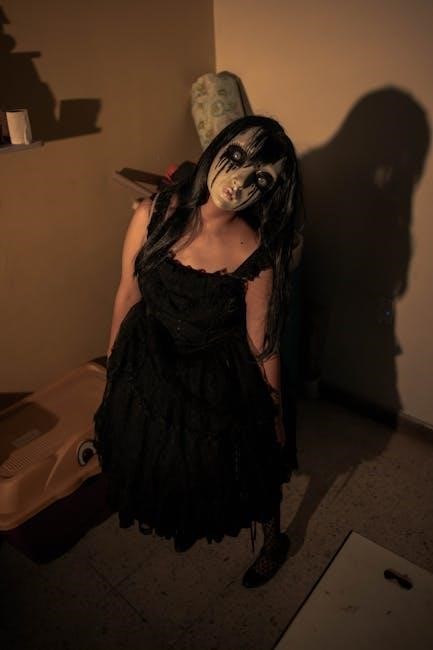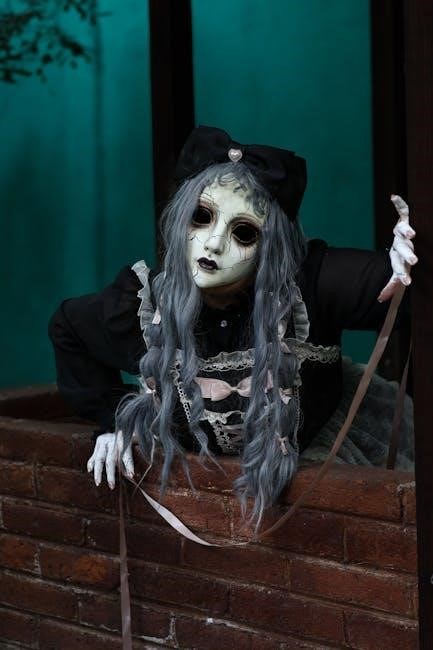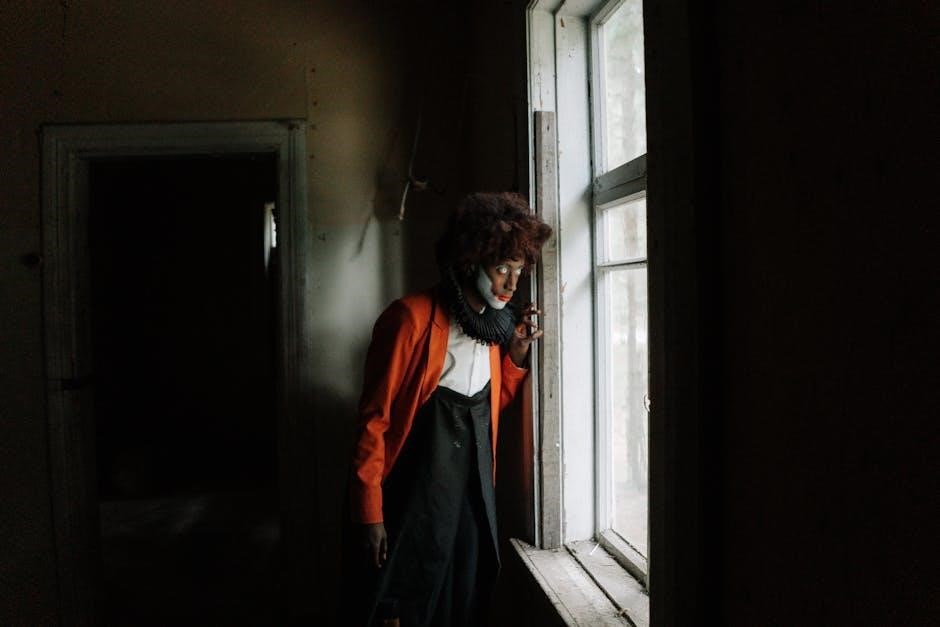Dread is a revolutionary horror RPG using a Jenga tower instead of dice‚ emphasizing collaborative storytelling and psychological tension․ This rules-light system creates intense‚ dynamic experiences․ The official PDF guide details core mechanics‚ themes‚ and tips for hosts‚ making it essential for both newcomers and seasoned players․
1․1 What is Dread?
Dread is a unique tabletop role-playing game designed to evoke a sense of horror and tension through its innovative mechanics․ Unlike traditional RPGs that rely on dice rolls‚ Dread uses a Jenga tower to resolve actions‚ creating a palpable sense of dread and uncertainty․ Players take turns pulling blocks from the tower‚ with the risk of it falling and resulting in their character’s removal from the game․ This system emphasizes psychological fear and collaborative storytelling‚ making it a standout experience in the RPG community․ The game is rules-light‚ focusing on narrative and atmosphere rather than complex mechanics‚ which allows players to immerse themselves in the horror themes․ Dread is particularly popular for one-shot sessions and is celebrated for its ability to craft memorable‚ harrowing stories through player interaction and the unpredictable nature of the Jenga tower․

1․2 Brief History of Dread
Dread‚ created by Nathan D․ Paoletta‚ was first released in 2005 under The Impossible Dream․ It gained attention for its unique Jenga tower mechanic‚ which replaced traditional dice rolls․ The game was inspired by horror movies and aimed to create a tense‚ collaborative storytelling experience․ Dread PDF became widely available‚ making it accessible to a broader audience․ Its initial success led to a second edition in 2012‚ refining the rules and expanding its reach․ The game has since become a cult classic‚ praised for its simplicity and ability to evoke fear and tension․ Dread’s popularity grew through word of mouth and online communities‚ solidifying its place in the indie RPG scene․ Its innovative approach has influenced other games‚ cementing its legacy as a groundbreaking horror RPG․
1․3 Key Features of Dread PDF
Dread PDF is renowned for its innovative mechanics and immersive storytelling․ A standout feature is the Jenga tower‚ replacing traditional dice rolls‚ which adds physical tension to the game․ Players pull blocks from the tower‚ creating suspense and a sense of impending doom․ Character creation is streamlined through questionnaires‚ allowing players to craft unique personas without complex stat allocation․ The game emphasizes collaborative storytelling‚ with players and the Host weaving a shared narrative․ Dread PDF also excels in creating a horror atmosphere‚ focusing on psychological tension rather than combat․ Its rules are flexible‚ accommodating various horror subgenres‚ from survival to supernatural tales․ The PDF format makes it accessible‚ with clear layouts and optional digital enhancements․ These elements combine to create a thrilling‚ unpredictable experience‚ fostering deep player investment and memorable sessions․ Dread PDF’s simplicity and creativity have made it a favorite among horror RPG enthusiasts worldwide․
1․4 Why Dread is Popular Among RPG Enthusiasts
Dread has gained a loyal following among RPG enthusiasts due to its unique blend of simplicity and intense gameplay․ The game’s reliance on the Jenga tower creates a palpable sense of tension‚ making every decision feel high-stakes․ This mechanic ensures that players are fully engaged and invested in the story․ Additionally‚ Dread’s focus on psychological horror and collaborative storytelling appeals to those who enjoy immersive‚ narrative-driven experiences․ The game’s accessibility—requiring minimal preparation and no complex rulebooks—makes it easy for new players to join․ Its horror themes also attract fans of the genre‚ offering a refreshing alternative to traditional fantasy RPGs․ The emotional and unpredictable nature of Dread fosters memorable moments‚ further cementing its popularity․ As a result‚ Dread has become a standout choice for players seeking a thrilling and unconventional tabletop experience․

Mechanics of Dread
Dread’s unique mechanics revolve around a Jenga tower‚ creating physical tension through its pull-and-remove system․ This rules-light approach emphasizes collaborative storytelling and player agency‚ fostering intense‚ unpredictable gameplay experiences․
2․1 The Jenga Tower: A Unique Gameplay Mechanic
The Jenga tower is Dread’s most iconic and suspenseful mechanic‚ serving as both a physical and narrative tool․ Players take turns removing blocks from the tower‚ with each pull heightening tension and unpredictability․ The tower’s instability mirrors the game’s horror themes‚ as characters face increasingly dire situations․ When the tower falls‚ it signifies a character’s death or a critical failure‚ creating emotional stakes․ This mechanic eliminates the need for complex dice systems‚ relying instead on physical skill and luck․ It fosters collaboration and nervous excitement‚ as players collectively hold their breath with each precarious pull․ The Jenga tower transforms a tabletop RPG into a visceral‚ shared experience‚ ensuring that every decision carries weight and every moment feels potentially catastrophic․
2․2 Character Creation via Questionnaires
Character creation in Dread is uniquely streamlined through the use of questionnaires‚ eliminating the need for complex stat allocation or lengthy character sheets․ Players answer a series of questions provided by the game master‚ which define their character’s background‚ fears‚ and motivations․ This method encourages creativity and ensures that each character is deeply personal and emotionally investable․ The questionnaires often focus on themes relevant to the game’s horror elements‚ such as personal phobias or tragic pasts․ This approach not only speeds up the setup process but also ensures that players are actively engaged in shaping their characters’ identities․ The simplicity of this system makes it accessible to new players while still allowing for rich‚ nuanced characters․ By focusing on narrative depth over mechanical complexity‚ Dread creates a more immersive and story-driven experience․
2․3 Collaborative Storytelling in Dread
Collaborative storytelling is a cornerstone of Dread‚ where players and the host work together to weave a gripping narrative․ Unlike traditional RPGs‚ Dread emphasizes shared responsibility for the story’s direction․ Players’ decisions and actions directly influence the plot‚ creating a dynamic and unpredictable experience․ The game encourages creativity and improvisation‚ as players are not confined by rigid character stats or predefined roles․ The host acts as a guide‚ presenting scenarios and challenges‚ while players drive the narrative forward through their choices․ This collaborative approach fosters a sense of ownership and immersion‚ as everyone contributes to the unfolding horror․ The Jenga tower mechanic further amplifies tension‚ as physical actions mirror the emotional stakes of the story․ Dread’s focus on teamwork and creativity ensures that no two games are alike‚ making each session a unique and memorable experience shaped by the collective efforts of all participants․
2․4 The Role of the Host in Shaping the Experience
The Host plays a pivotal role in shaping the Dread experience‚ serving as both a storyteller and a game master․ They are responsible for creating and presenting the scenario‚ guiding the narrative‚ and maintaining the game’s atmosphere․ The Host sets the tone early on‚ ensuring players understand the horror theme and collaborative nature of the game․ They prepare the setting‚ non-player characters‚ and conflicts‚ while also adjudicating the rules and managing pacing․ The Host must balance storytelling with player agency‚ allowing decisions to influence the outcome․ Their ability to improvise and adapt to unexpected choices is crucial․ By fostering tension and engagement‚ the Host ensures a memorable and immersive experience․ Ultimately‚ the Host’s creativity and leadership are key to making Dread a thrilling and unique horror RPG‚ blending fear‚ storytelling‚ and collaborative gameplay seamlessly․

Themes and Atmosphere in Dread
Dread emphasizes psychological horror‚ isolation‚ and tension‚ creating a chilling atmosphere through collaborative storytelling and immersive scenarios that evoke fear and suspense‚ drawing players into a dark‚ unsettling experience․
3․1 Common Horror Elements in Dread Scenarios
Dread scenarios frequently incorporate classic horror elements such as creepy atmospheres‚ supernatural entities‚ and psychological terror; Themes often revolve around isolation‚ abandonment‚ and the unknown‚ heightening tension․ Many scenarios feature abandoned locations‚ mysterious disappearances‚ or ancient evils‚ which are staples of the horror genre․ The game leans heavily on psychological fear‚ where the uncertainty of what might happen next is as terrifying as the events themselves․ Players are often exposed to moral dilemmas‚ forcing them to confront their characters’ darkest choices․ The Jenga tower mechanic amplifies the sense of impending doom‚ as each pull could lead to a character’s demise․ These elements collectively create a chilling experience‚ making Dread a standout in horror RPGs by blending narrative and mechanical tension to evoke fear and unease in players․ The game thrives on these common horror tropes‚ delivering unforgettable and unsettling stories․
3․2 Creating Isolation and Tension
Dread excels at crafting isolation and tension through its gameplay mechanics and narrative design․ The Jenga tower serves as a physical manifestation of escalating tension‚ as players nervously anticipate the next move․ Scenarios often place characters in remote or confined settings‚ such as abandoned asylums‚ isolated research stations‚ or eerie forests‚ which naturally foster a sense of isolation․ The game’s focus on collaborative storytelling ensures that players are deeply invested in their characters’ fates‚ amplifying the emotional stakes․ Additionally‚ the Host’s role in describing ominous environments and subtle horrifying details enhances the immersive atmosphere․ Dread’s ability to blend psychological tension with the unpredictability of the Jenga tower creates a unique experience where fear is not just a theme but a palpable feeling shared by all players․ This combination of isolation and tension is what makes Dread stand out as a masterclass in horror storytelling․
3․3 The Psychology of Fear in Gameplay
Dread masterfully leverages the psychology of fear to create a deeply immersive experience․ By using the Jenga tower as a mechanic‚ the game taps into players’ primal fear of failure and the unknown․ The tower’s instability creates a sense of dread that mirrors the game’s horror themes‚ making players physically tense․ The Host’s ability to craft scenarios that exploit common phobias and psychological vulnerabilities further amplifies fear․ Dread also employs the power of imagination‚ leaving much to the players’ minds‚ which often conjures more terrifying scenarios than explicit descriptions․ This psychological engagement ensures that fear feels personal and visceral․ The game’s design ensures that fear is not just a theme but a mechanic‚ making it a standout example of how horror can be effectively integrated into tabletop RPGs to create unforgettable experiences․

Scenarios and Supplements
Dread offers a wide variety of scenarios and supplements‚ expanding gameplay possibilities and themes․ These resources provide fresh stories‚ mechanics‚ and tools‚ enhancing the horror experience for players and Hosts․
4․1 Popular Scenarios for Dread
Dread features a variety of popular scenarios that cater to different horror tastes․ Titles like The Killer and Halloween Survival are fan favorites‚ offering unique twists and intense gameplay․ These scenarios are designed to maximize tension and immersion‚ leveraging the game’s mechanics to create unforgettable experiences․ Many are included in the Dread PDF‚ while others are available as supplements․ Players can choose from survival horror‚ psychological terror‚ or even supernatural mysteries‚ ensuring a diverse range of themes․ The scenarios are crafted to challenge players morally and emotionally‚ making each session feel distinct․ Whether it’s navigating a haunted house or escaping a deadly predator‚ Dread’s scenarios deliver thrilling narratives that keep players on edge․ The popularity of these scenarios stems from their ability to blend storytelling with the game’s iconic Jenga tower mechanic‚ creating a truly unique horror RPG experience․
4․2 Free and Paid Supplements Available

The Dread PDF ecosystem is enriched by a variety of free and paid supplements‚ offering players and hosts additional content to expand their gameplay․ Free supplements‚ often created by the community or released by the game’s developers‚ provide new scenarios‚ character options‚ and rules tweaks․ These are great for introducing new players or refreshing existing campaigns․ Paid supplements‚ on the other hand‚ deliver more polished and extensive content‚ such as deluxe scenarios‚ thematic expansions‚ and deeper dives into specific horror subgenres․ Popular paid supplements include The Dread Handbook and Beware the Devil‚ which add layers of complexity and atmosphere to the game․ Both free and paid options ensure that players can tailor their Dread experience to suit their preferences‚ keeping the game fresh and exciting for veteran enthusiasts and newcomers alike․
4․3 Creating Custom Scenarios for Dread
Creating custom scenarios for Dread allows players to craft unique and personalized horror experiences tailored to their group’s preferences․ The process begins with a strong premise or theme‚ ensuring it aligns with the game’s atmospheric and horror-driven nature․ Hosts can draw inspiration from various sources‚ such as movies‚ books‚ or real-world folklore․ Key elements include establishing a setting‚ defining characters‚ and designing challenges that integrate Dread’s signature mechanics‚ like the Jenga tower․ Balancing horror elements with gameplay is crucial‚ as scenarios should evoke fear while remaining fun and engaging․ Hosts are encouraged to outline key scenes‚ establish clear stakes‚ and incorporate player choices to enhance immersion․ Playtesting with a small group can help refine the scenario‚ ensuring it delivers the intended tension and excitement․ Custom scenarios not only expand Dread’s versatility but also keep the game fresh and dynamic for long-time enthusiasts․

Running a Dread Game
Running a Dread game requires masterful storytelling‚ careful pacing‚ and fostering player engagement․ The Host sets the tone‚ while players’ choices drive the terrifying journey‚ making each session unique․
5․1 Tips for First-Time Hosts
For first-time hosts‚ preparation is key․ Start by creating a simple yet compelling scenario‚ ensuring it aligns with the horror theme․ Familiarize yourself with the rules‚ especially the Jenga tower mechanic‚ to avoid confusion during gameplay․ Practice building the tower beforehand to understand its dynamics․ Set the atmosphere with ambient music or dim lighting to enhance immersion․ Encourage players to collaborate and embrace their roles actively․ Keep the pacing steady‚ allowing tension to build naturally without rushing․ Be flexible—players may take unexpected paths‚ so adapt your storytelling accordingly․ Most importantly‚ remember that mistakes are part of the learning process․ Stay calm‚ engage with your players‚ and let the game unfold organically․ A positive attitude and willingness to improvise will make your first session memorable and enjoyable for everyone involved․
5․2 Managing Pacing and Tension
Managing pacing and tension is crucial for creating an immersive horror experience in Dread․ Start by setting the tone early‚ using vivid descriptions to establish the atmosphere․ Vary the tempo of the game by balancing quiet‚ suspenseful moments with intense‚ high-stakes scenarios․ The Jenga tower is a powerful tool for building tension—use it strategically‚ ensuring pulls from the tower align with key narrative beats․ Avoid rushing through critical moments; let players absorb the fear and uncertainty․ Pause occasionally to allow the weight of decisions to sink in‚ especially before pivotal actions․ Encourage players to voice their fears and anxieties‚ as this enhances the collective tension․ Remember‚ pacing is a delicate balance—too slow‚ and players lose interest; too fast‚ and the horror loses impact․ By mastering this rhythm‚ you can craft a game that keeps players on edge from start to finish;
5․3 Handling Player Deaths and Continuity
Player deaths in Dread are inevitable and often emotionally resonant‚ serving as a testament to the game’s perilous nature․ When a character dies‚ it’s essential to handle the moment with care to maintain the game’s tension and narrative flow․ Deaths should feel meaningful and consequential‚ reinforcing the stakes of the story․ After a death‚ allow the remaining players to process the loss‚ as this deepens their emotional investment․ The game should continue seamlessly‚ with the story adapting to the new dynamics․ Avoid undoing deaths or making them feel inconsequential‚ as this undermines the game’s gravity․ Instead‚ use the death as a catalyst for further tension or plot development․ Ensure that deceased players remain engaged by giving them observational roles or even allowing them to contribute to the atmosphere․ This approach maintains continuity and keeps everyone invested in the unfolding horror․
5․4 Encouraging Player Investment in the Story
Encouraging player investment in the story is crucial for a compelling Dread experience․ To foster this‚ the Host should actively listen to players’ ideas and incorporate them into the narrative‚ making everyone feel heard and valued․ Encourage players to take ownership of their characters by sharing their motivations and fears‚ which can be achieved through pre-game questionnaires․ Personalizing the horror elements to each player’s phobias or preferences enhances emotional engagement․ Additionally‚ allow players to make meaningful choices that impact the story’s direction‚ creating a sense of agency․ Maintaining a collaborative atmosphere ensures players feel connected to the unfolding tale․ By doing so‚ the Host transforms players from passive participants into active storytellers‚ deepening their emotional connection to the game and heightening the tension that Dread is known for․

Tools and Resources
Explore essential tools and resources to enhance your Dread experience‚ including Jenga towers‚ character sheets‚ and rulebooks․ Digital aids like scenario generators and online forums also enrich gameplay․
6․1 Essential Items Needed to Play Dread
To play Dread‚ you’ll need a few key items to ensure a smooth and immersive experience․ First and foremost‚ a Jenga tower is central to the game’s tension mechanic‚ serving as a physical representation of the characters’ precarious situations․ A printed or digital copy of the Dread rulebook is also essential‚ providing the framework for gameplay‚ character creation‚ and scenario design․ Players should have pens or pencils for filling out character questionnaires‚ which are a unique aspect of the game․ A flat‚ stable surface is necessary for constructing and manipulating the Jenga tower․ Optional but highly recommended are thematic props‚ such as dim lighting or ambient music‚ to enhance the horror atmosphere․ Lastly‚ a willingness to embrace collaborative storytelling and the unpredictability of the Jenga mechanic is crucial for everyone involved․
6․2 Digital Tools for Enhancing Gameplay
Digital tools can significantly enhance the Dread experience‚ offering convenience and creativity for both players and hosts․ Virtual tabletop platforms like Roll20 or Fantasy Grounds allow for remote play‚ making it easier to gather players worldwide․ Online character builders and questionnaire generators streamline the character creation process‚ ensuring everyone is prepared for the game․ Random name generators and scenario idea tools can add depth to the story and NPCs‚ keeping players engaged․ Ambient sound and music apps‚ such as Noisli or Tabletop Audio‚ can heighten tension and immersion․ Additionally‚ digital PDF annotation tools enable hosts to mark up scenarios and track progression effortlessly․ Virtual Jenga tower simulators provide an innovative way to play online‚ eliminating the need for a physical tower․ These tools not only modernize gameplay but also expand the possibilities for storytelling and collaboration in Dread․
6․3 Community and Forums for Dread Enthusiasts
The Dread community is vibrant and supportive‚ with numerous forums and platforms where enthusiasts gather to share ideas‚ resources‚ and experiences; Reddit’s r/DreadRPG and r/LFG are popular hubs for connecting with players and hosts‚ while The Dreadful Discord offers real-time discussions and community events․ Fans often share custom scenarios‚ character questionnaires‚ and tips for enhancing gameplay․ These spaces foster collaboration‚ with players and creators alike contributing to the game’s growth․ Community-driven initiatives‚ such as virtual game nights and livestreams‚ provide opportunities for newcomers to join in and learn from experienced players․ Forums also host discussions about game theory‚ horror storytelling‚ and innovative ways to use the Jenga tower mechanic․ The sense of camaraderie and shared passion within these communities makes them invaluable for both seasoned enthusiasts and those new to Dread․
Dread PDF offers a unique blend of horror and collaborative storytelling‚ making it a standout RPG experience․ Its innovative mechanics and psychological depth ensure unforgettable sessions for players and hosts alike․

7․1 The Appeal of Dread in Modern RPGs
Dread PDF stands out in modern RPGs for its unique blend of simplicity‚ psychological tension‚ and collaborative storytelling․ Unlike traditional RPGs‚ Dread eliminates complex rulebooks and instead focuses on player-driven narratives and emotional investment․ The game’s reliance on a Jenga tower creates an unparalleled sense of physical and psychological tension‚ making every decision feel high-stakes․ Its horror-centric themes resonate deeply with players seeking immersive‚ atmospheric experiences․ Additionally‚ Dread’s emphasis on character backstory and personal motivations fosters a connection between players and their roles‚ enhancing the emotional impact of the game․ This minimalist yet impactful design makes it accessible to newcomers while offering depth for veteran players․ As a result‚ Dread has carved a niche in the RPG community‚ appealing to those who value storytelling‚ creativity‚ and unforgettable gameplay․
7․2 Final Thoughts on Playing and Hosting Dread

Playing and hosting Dread offers a uniquely rewarding experience that blends creativity‚ tension‚ and collaboration․ For players‚ the game encourages deep emotional investment in their characters‚ making every decision feel personal and consequential․ The Jenga tower mechanic adds a visceral‚ unpredictable element that keeps everyone on edge․ For hosts‚ Dread provides an opportunity to craft compelling narratives and guide players through a shared story‚ fostering a sense of community and camaraderie․ First-time hosts should embrace flexibility and focus on creating an immersive atmosphere rather than adhering to rigid plans․ Dread’s minimalist design allows for endless creativity‚ making it accessible to newcomers while offering depth for experienced players․ Whether you’re at the table or behind the screen‚ Dread promises an unforgettable journey of fear‚ storytelling‚ and connection․ Its simplicity and innovation make it a standout choice for anyone seeking a fresh take on tabletop RPGs․



